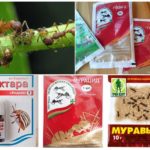How to get rid of ants in the garden folk remedies
Content
- Mechanical method of struggle
- Use of chemicals
- Folk remedies for ants in the garden
With the arrival of warm days in the suburban areas, everything starts to grow, bloom and smell. However, fragrant plants attract the attention of not only lovers of garden works, there are also ants on the beds, which in large numbers pose a serious danger to the future harvest.They eat up the roots, leaves and fruits of plants, contribute to the breeding of aphids and soil contamination, spreading various bacteria on their paws. Therefore, the question of how to get rid of the ants in the beds, remains relevant for each owner of the dacha.
Where ants come from
Frequent guests in the garden are garden ants. They come from neighboring land plots and build their anthills directly on the beds or under the roots of trees. In search of food, they travel in whole families, and finding a suitable site - they settle on it.
The presence of edible plants leads to an increase in their population. Insects build multi-level anthillsin which calm winter in the cold season. Therefore, if you do not get rid of them in a timely manner, then in the spring pests will begin to attack the garden beds with a new force.
On a note!
There are also forest ants in the garden beds. However, there they manage not for long, returning to the night in their forest anthill. It is not so difficult to get rid of these insects - it is enough just to scare them away.
How to get rid of pests
To get ants off the garden in various ways.
Mechanical method
Finding on the beds in the garden of ants, you need to find their nest. And if it is small, it is better to use a more humane way - to move the anthill into the forest. To do this, you need to remove the upper part of the ant's nest with a shovel and carefully dig up its core along with the uterus and future offspring.
If the anthill is of very overall dimensions, then it will not be possible to remove ants from the bed in this way, it will be necessary to destroy the nest. It must be stirred and sprinkled. ash or pour boiling water. You can also use an insecticidal preparation or pour a nest of flammable liquid and set fire to it. After this procedure, the soil is dug up, mixing the ground with ash.
Use of chemicals
To accelerate the exhausting and time-consuming process of combating garden pests by using chemical agents. The use of insecticides makes it possible to get rid of pests in the shortest possible time.
Chemical preparations against ants are granulated, liquid and powdered,and also available in pill form. The following insecticides are in great demand among summer residents: Aktara, Muracid, Muratox, Fenaxin, Thunder-2, Ant-eater, Fitar and others.
The composition of all these drugs include insecticidal components that affect the body of insects. Which leads them to paralysis, and later to death.
However, despite the fact that chemicals are the most effective way to combat ants, we should not forget that they are harmful not only to ants, they are also unsafe for humans and domestic animals. Therefore, many lovers of garden and gardening works prefer to fight ants with folk remedies.
Folk remedies
Taking care of the ecology of the garden and the crop grown on it, it is preferable to use folk remedies for ants in the beds.
- To get rid of ants, it is necessary to treat the beds with a decoction of tobacco leaves, wormwood, tansy, mustard or black elderberry. The smell of these plants has repellent properties. You can also water the plants with broth of onion peel.
- Do not like ants citric acid and vinegar. Regular treatment with solutions containing these components will easily get rid of unpleasant neighborhoods.
- Another folk remedy is cooking. bait. So borax or boric acid mixed with sugar and a little water. The poison is laid out near the anthill or along the paths of moving garden pests. Lures are also made sweet, based on yeast and even ground beef.
- A good result is lime mixed with soda. This mixture is sprinkled with the places where insects are most commonly found.
- Often, vegetable oil is used to destroy the anthill and its inhabitants. It is poured into the nest itself, having previously removed the upper part of the ant dwelling.
- Also effective ant ridding garlic. It is planted around the perimeter of the garden or spread sliced slices right on the cucumber garden between seedlings. In a similar way acts on insects and tops of tomatoes.
It is possible to affect pests by attracting birds, which are willing to eat ants. To do this, scatter between the beds millet or other cereal. However, this method is not recommended for use in areas with strawberries andthe salad.











